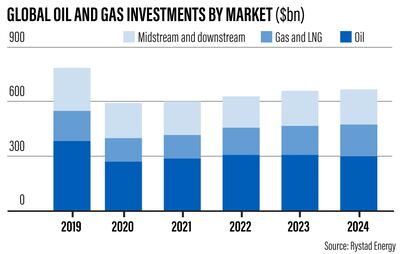Global oil and gas investments will increase more than 4.3 per cent annually to reach $628 billion this year as the industry recovers from the pandemic and from the hurdles posed by the Omicron variant, according to a report by consultancy Rystad Energy.
The increase in investment will largely be driven by a 14 per cent year-on-year rise in upstream gas and liquefied natural gas investments in 2022, the independent energy research and data analytics company said.
Upstream gas and liquefied natural gas will be the fastest-growing segment this year, with investments rising to nearly $149bn, from $131bn in 2021. This falls short of the pre-pandemic total but investment in the sector is expected to surpass the 2019 levels of $168bn in two years, reaching $171bn in 2024, Rystad said.
Upstream oil investments are projected to rise 7 per cent yearly to $307bn in 2022. However, the midstream and downstream investments will fall 6.7 per cent on annual basis to $172bn this year.
The pervasive spread of the Omicron variant will inevitably lead to restrictions on movement in the first quarter of 2022, capping energy demand and recovery in the major crude-consuming sectors of road transport and aviation, Rystad Energy’s head of energy service research, Audun Martinsen, said.

“But despite the ongoing disruptions caused by [the] Covid-19, the outlook for the global oil and gas market is promising,” he said.
Global shale investments are predicted to surge 18 per cent to reach $102bn this year, almost $16bn more than last year, Rystad said.
The offshore investments are set to reach $155bn, up 7 per cent annually, while conventional onshore will jump 8 per cent to $290bn this year, it said.
This year’s investment growth is very much “pre-programmed” by the $150bn worth of greenfield projects sanctioned last year, up from $80bn in 2020, Rystad said.
Approving activity in 2022 is likely to mirror last year’s levels, with a similar amount of project spending to be unleashed in the short to medium term, it said.
Global oil demand is expected to plateau by the mid-2030s. Crude is expected to remain the biggest component of the international energy mix until 2045, as the world’s population increases and the global economy more than doubles in size to $270 trillion, Opec said in its World Oil Outlook 2021 report in September.
Demand is forecast to rise by 17.6 million barrels per day in two and a half decades, growing to 108.2 million bpd in 2045 from 90.6 million bpd in 2020, according to Opec.
Regionally, Australia and the Middle East stand out in terms of investments, Rystad’s report showed.
Investments in Australia are expected to rise 33 per cent owing to the greenfield gas developments. In the Middle East, investments will rise 22 per cent this year as Saudi Arabia boosts its oil export capacity and Qatar expands production and LNG export capacity, Rystad said.
The consultancy, though, pointed out that an “outstanding concern” in 2022 is execution challenges related to the pandemic and increased inflationary costs for steel and other input factors.
“These are likely to make operators mildly cautious regarding significant capital commitments … major offshore operators are being challenged on their portfolio strategy as the energy transition unfolds, with many exploration and production companies already directing investment budgets to low-carbon energy sources.”
For offshore contractors, the energy transition could be advantageous for wind power developments.
Spending in the offshore wind sector reached almost $50bn last year, double the 2019 levels. By 2025, Rystad expects offshore wind investments will rise to $70bn as demand for clean energy surges.
By contrast, the offshore oil and gas sector is set to face a challenging energy transition period. Oil demand is likely to peak in the next five years, capping offshore investment at about $180bn in 2025.





